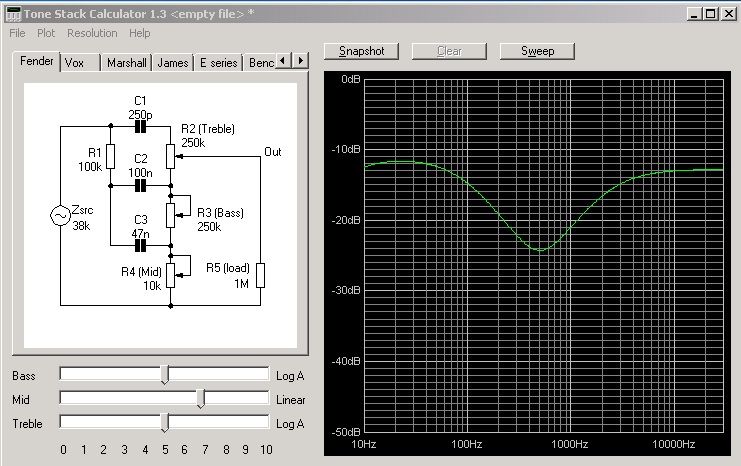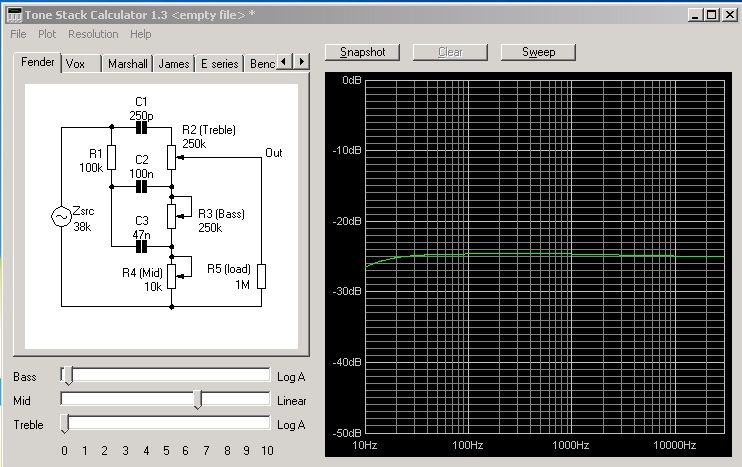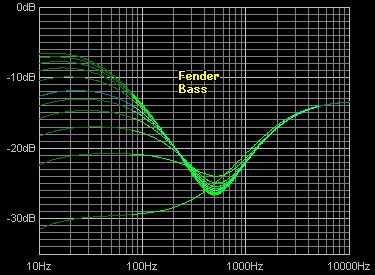-
I have seen a number of amp EQ discussions on this forum desiring an amplifier with a neutral frequency response when set at 5-5-5 with bass, mid and treble EQ controls centered at specific frequencies to alter the tone. I find this desire curious in that many of the classic tube amps that I associate with pleasing tones produce highly shaped frequency responses (like vintage Fender BF amps). Flat response amps in my experience sound like plugging your guitar into a PA system.
This is the frequency response of a Fender BF tone-stack with set at a very typical 5-7-5. You can see that the frequency response dips from 80 Hz to about 500 Hz and rise to 1,300 Hz (and beyond). So this mid-scooped frequency response sounds musical in the context of a band.

If I take a Fender BF style tone-stack and attempt to get as close a flat response as possible I set the EQ to 0.2-10-0. When I do this, I really don't like the way the amp sounds at all. I have never seen anyone perform with an amp set like this.

The fundamental frequencies on 6-string, 21 fret archtop is 82 - 1,109 Hz. Everyone has a slightly different definition of bass, mids and treble. Personally, I consider bass to be everything below about 200 Hz. Midrange to me comprises the lion-share of the instrument. These are frequencies between 200-600 Hz. Treble to me are frequencies >600 Hz which is the upper reaches of the B and high E strings.
If you look at a Fender style bass control, you can see that it most profoundly impacts the frequencies <200 Hz.

The midrange control is centered between 500-600 Hz, but affects frequencies across the fretboard (200-1,200 Hz).

The BF treble control really effects frequencies >400 Hz and shifts the mid-scoop downward from 500-600 Hz to about 300 Hz.

I have absolutely no idea what the frequency response at the settings that I like on my Evans RE200 looks like, but I know that it sounds musical and pleasing to me. I do understand the desire to have EQ controls that shape your tone in relevant and musical manner (e.g. Treble not centered @ 10,000 Hz), but what's with the desire for a flat response with an amp set at 5-5-5? Are you wanting to start with a "blank canvas" so to speak?
-
03-29-2014 05:53 PM
-
That's usually where I start . . totally flat. Then, I gradually adjust to my liking and based upon which of my guitars I'm playing. I've been playing carved solid spruce top arch tops with a floater lately. As such, my current setting is treble at 2.5, bass at 7.5, volume at 2.5 and reverb at 2.5. That's on the Fender Pro Reverb. The Fender Princeton Reverb at a different setting. Volume and tone controls are always wide open.
-
i agree with you but several posters around here seem to think that a BF fender amp sounds terrible for jazz. I couldn't disagree more but I think after a decade of flat sounding amps folks are conditioned that a dull, flat tone is the epitome of jazz tone. I know my tone is dull and flat but I chose to get that tone out of compromise because I don't want to put up with the weight or hassle of tubes but nothing beats a great BF tube amp for jazz guitar tone IMO. At least nothing I've ever played through.
-
Patrick,
By "totally flat" you mean 5-5-5 and not a flat frequency response correct? Both the Pro Reverb and Princeton have highly shaped EQs at 5-5-5.
Bob
 Originally Posted by Patrick2
Originally Posted by Patrick2
-
Agreed. Totally flat was the arong term. I should have said . . .totally neutral. Both are black face circuitry.
 Originally Posted by iim7V7IM7
Originally Posted by iim7V7IM7
-
I just set what ever rig I'm using till my ears are happy! And sometimes in some rooms,on some gigs, my ears are never happy,LOL!
-
I dig those visuals and I agree with OP.
I'm a fan of fender tube amps tone (though not a fan of the weight and maintenance). For me that's the home base tone. If I have a choice I want the "fender scooped middle" tone to come from my amp when the treble middle and bass are at 12 o'clock.
I had an amp modeler whose instruction was; It's best to use a PA but if you use an amp set the treble and bass to zero and the middle to 10. They must have been thinking fender as that is pretty much what your analysis shows.
And if someone using a Fender amp really wants to start at "total flat" the setting would be: treble 0, middle 10, bass 0. Ha!
Obviously when most say "totally flat" they don't mean "totally flat".Last edited by fep; 03-29-2014 at 06:57 PM.
-
1970 Pro Reverb and 1970 Princeton Reverb amps don't have a middle. Just treble and bass.
-
they actually have a middle but it's a fixed resistor value
 Originally Posted by Patrick2
Originally Posted by Patrick2
-
Great graphics..
This is why I got an Empress ParaEQ to go with the various amps and powered speakers around here.
-
Are you wanting to start with a "blank canvas" so to speak?
I think there's some confusion between what are attractive guitar sounds and the value, if any, of being able to get a flat tone @555, or indeed at some other known setting.
Some players feel that being able to get a flat tone at a given place gives a 'reference point', or blank canvass as you put it, and if a guitar sounds good at that point then there's a basis for setting a better sound to taste.
Others may like the flat guitar sound anyway, and just work with that, so for them a flat reference point is essential.
I never set my SS amps at 555, but it's useful to know where the flat setting is. I tend to pull down the middle response somewhat to give a 500hz dip, like most others do.
BTW that little tonestack modeller pc program is extremely useful if you want to look at other tonestacks as an alternative, or if you want to see what the effect of tweaking a component value will be. It's surprising how changing the 'mid' cap value to 22nf fattens up the sound while retaining the scoop on a AB763 fender stack. The 5E8 fender stack can actually achieve a flat mid sound, if you want to try modelling that one.
-
Ever tried an Ampeg? Great sound, used by many jazz players since the 60s and... flat at 5-5-5. (baxandall eq). Dumbles and their relatives and some tweeds are also not far from flat. And modding a blackface with more mids was done by a lot of jazz players (decreasing the mid cap value or increasing the mid pot value or both).
 Originally Posted by iim7V7IM7
Originally Posted by iim7V7IM7
Baxandall eq's tend to be much more easier to achieve a balanced sound across the spectrum with humbuckers, in my experience. Blackfaces can be hard to tame sometimes.
And, unlike the curious "jazz players got used to a dull sound" suggestion, maybe different taste? Some people like mid scooped and some mid heavy? I personally enjoy both.
Also - if you use that same program under James (baxandall eq) you can see that boosting the bass and the treble leeds to a mid scooped sound... (and a lot of these designs already have an active mid control that can introduce a mid scoop without boosting the bass and the treble).Last edited by jorgemg1984; 03-30-2014 at 09:15 AM.
-
So, I am taking away from this post that its meaningful adjustability that is important and not a flat response.
In my experience is that the flatter response amps that I have owned is my 5E3 Deluxe. Here is what the response of a 5E3 looks like on the bright channel through the bright input with the tone control set at 3, 6 and 9:

A very flat response compare to a more modern Fender BF tone-stack shown in my earlier posting. It sounds OK at best for archtop jazz, but I much prefer the clarity of the scooped mids of a BF type tone-stack. As I said, I have no idea what my Evans frequency response looks like with my amp set the way that I typically like it, but I suspect that it is far from flat. I think that it is the EQ control that differentiates it from my previous SS amp from AI.
I suspect that we all go about this differently and how we go about this affects what we think about an amp's EQ. To me, I think what is important is that an amp provide meaningful tone shaping that you can hear on your guitar.
My method of setting up EQ is fairly simple. Basically, I don't want bass to dominate but be there in a balanced way, I don't want treble to be shrill or to dark and I want mids to be present and balanced across a number of strings. I use the open low E, A and D strings (82-146 Hz) to adjust my bass and the upper portions of B and high E strings (~600-1,200 Hz) to adjust the treble response. I play A-D-G-B string based chords in the 8th to 15th fret area to adjust the mids (~200-600 Hz, sometimes single notes fool me here). I use other amp EQ controls to adjust harmonic content. At first, I was taken aback by the foreign nature of my Evans EQ, but its actually easy to use.
I'd be interested to hear how you all set up your EQ?
-
Guitar: L5-CES copy, 12-52 Flatwound D'Adds, A3/A2 modded Duncan Jazz set.
Boutique Twin BF type amp in the clean channel.
Gain: max before breakup (3.5)
Bass: 2.3
Mid: 3
Treble: 4-4.5
HTH,Last edited by LtKojak; 03-30-2014 at 09:51 AM.
-
Wondering if this might be why people are looking for flat in the first place? They're just using the amp to run their digital rig which is already eq'd ?
 Originally Posted by fep
Originally Posted by fep
-
Sometimes (often times?) ignorance truly is bliss. A whole bunch of technical input regarding EQ-ing amps and tone based upon graphic charts showing db rating, Hz measurements, cap values and God knows what else. I'm at a total loss as to how to determine if any of it is at all relavent, once the amp is off the technician's bench and he has dialed in a specific capability for the amp, based upon the player's desires.
I guess there are many different methods one can start at to achieve a desired tone. Some roll all of the dials to 1 and gradually add . . others like a specific starting point, ie my own of treble at 5 and bass at 5. Then increase or decrease based upon personal preference . . and keep tweaking until you find something you like. With the variety of guitars . . and pickups I have . . it's a constant, but very minor chore. My arch tops have a variety of at least 10 different pickups and/or configurations . . one inset humbucker, two inset humbuckers, floating single coil, floating dual coil.
As one changes guitars . . most if not all of the info stated in the charts above seemingly goes right out the window . . and the tweaking starts all over again. Then too . . there are those players who like to ride the volume and tone controls on the guitar. Then the pots and caps play a roll in the resulting tone.
I kinda like the old school jazzers, who dial their tone in at home . . . lock that in . . then just show up at a gig, plug in, spend a minute or less tweaking for the room and band instrumentation . . . and live with what they've got.
-
Yeah, regardless of the eq measurements, for me fender had defined what I think of as "flat" back when I had my first fender amp in the 70s. "Flat" for me is a fender amp with treble, bass, and middle at 5 5 5.
Using the word "flat" that way is what I think of as guitar amp flat. Not the same as a flat frequency response.
-
That's how I've always defined it also. But, I've learned in this thread that "totally flat" is technically incorrect terminology for that. I'm still at a loss with the claims of setting the middle at 5 on an older Fender tube amp.? Other that going in to the chassis . . . how do you do that?
 Originally Posted by fep
Originally Posted by fep
-
Patrick,
Yeah, only the Fender BF Twin Reverb and Dual Showman Reverb had the mid control in their tonestacks. Most BF amps (e.g. princeton reverb, deluxe reverb, vibroverb, bandmaster, pro reverb and super reverb etc.) had simple bass/treble baxandall controls (your point I am guessing). The same concept that I outlined applies to these as well.
:-)
Bob
-
My amp was a 70 something silver face super reverb. To the best of my recollection it had a middle tone control.
 Originally Posted by Patrick2
Originally Posted by Patrick2
-
Here's a great resource...
 Originally Posted by fep
Originally Posted by fep
The Fender Amp Field Guide
-
 Originally Posted by iim7V7IM7
Originally Posted by iim7V7IM7
Thanks and yep they had a middle tone control.
The Fender Amp Field Guide
-
According to a biography of Grant Green by his daughter in law, his amp settings were bass and treble at 0 and middle at 10. That would put it at totally flat response.
-
For solo guitar I like scooped. For single note playing in a group I like the opposite, but then I like Par Martino's tone!
-
With Fender tone stacks, I like to start at 0-10-0 then gradually dial up bass and treble to taste. The final bass and treble settings depend on the guitar, room, other instruments, and whatever mood I'm in.
 Originally Posted by Chazmo
Originally Posted by Chazmo
I'd suggest some definitions:
"Flat" = flat frequency response
"Center Position" = all tone pots at 5 (for Fender knobs)
"Neutral" = whatever you feel is the ideal balanced tone
The third term is obviously subjective, varying from person to person. Therefore it's impossible to design a tone stack that is "neutral" at 5-5-5 for every player.
Also, keep in mind that the frequency responses of magnetic pickups and guitar speakers/cabinets is far from flat, and vary radically. The scooped Fender tone stack probably helps compensate for this. But I still prefer to start "flat" (0-10-0 for Fender) then dial in whatever scoop my ears tell me I need.




 Reply With Quote
Reply With Quote







Melody between melody
Today, 03:25 AM in Chord-Melody